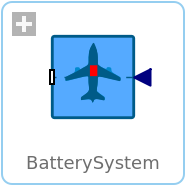WOLFRAM SYSTEM MODELER
BatterySystemModel for battery system |
|
Diagram
Wolfram Language

SystemModel["Aircraft.Physical.FixedWing.Parts.Propulsions.EnergyStorages.BatterySystem"]

Information
This model extends the EnergyStorageBase model and calculates the size of the battery system and the forces and torques due to the mass and inertia tensor of the battery system (if the weight estimation method is used). This model is included in the ElectricPropulsion model.
Parameters
The battery system parameters shown in Figure 1 are declared on the ElectricPropulsion model and propagated from there to this model. The battery system consists of one single battery. This model requires the properties of the battery cell, namely the battery cell specific energy (eCell) and energy density (Ucell), that are used to estimate the properties of the entire battery system, including the mass and volume due to battery casing, cooling and installation. Additionally, the parameter for the battery system's energy capacity (Ebattery) is naturally used to estimate the battery system size and mass. The battery center of mass location along the aircraft body x axis (xBattCM) is left completely for the user to decide, as it has has such a large impact on the aircraft longitudinal stability.
If the exact volume, mass, moments of inertia, the specific energy or energy density on the battery system is known even though the weight estimation method is used, their values can be entered in the Estimated Battery System Properties tab, thus bypassing the equations to estimate their values.
Figure 1: Battery system parameters.
All other parameters of this model are propagated down from the AircraftBase model, and they are listed in the Propagated Properties tab. Thus, their values can and should be left unchanged in this model.
Battery System Mass Properties
For solving the battery system mass, an empirical relationship presented by Löbberding [1] is used to derive the estimated battery system specific energy from the given cell specific energy. Then, the mass of the battery system is calculated by multiplying the battery system's energy capacity by the estimated battery system specific energy. The derivation of the estimated battery system mass is also described in section 3.4.6 in Reference [2].
The moments of inertia of the battery system are solved based on a cuboid with a volume, which is estimated through an empirical relationship between the cell and battery system energy densities [1]. The width and height of the cuboid are set to values such that the battery system fits well inside the fuselage, while its length is the volume divided by the set width and height. The complete derivation of the battery system dimensions and moments of inertia is described in section 3.6.3 in Reference [2].
The battery system center of mass location on the aircraft body x axis is defined by the xBattCM parameter, whereas on the body y axis it is on the fuselage centerline and on the body z axis at a distance of 0.159075 * fuselage height below the fuselage reference plane due to the cuboid dimensions described in section 3.6.3 in Reference [2].
Energy
This model also calculates the energy remaining in the battery (Ef) by subtracting the consumed energy from the given battery system's energy capacity. In the EnergyStorageBase model, the first time the derivative of the Ef value is calculated, that is the gross power consumed by all the electric engines (Pf).
References
[1] Löbberding, H., S. Wessel, Offermanns, C., Kehrer, M., J. Rother, H. Heimes, & A. Kampker. (2020).
"From cell to battery system in BEVs: Analysis of System Packing Efficiency and Cell Types. World Electric Vehicle Journal, 11(4), 77
Available at: https://doi.org/10.3390/wevj11040077.
[2] Erä-Esko, N. (2022). "Development and Use of System Modeler 6DOF Flight Mechanics Model in Aircraft Conceptual Design."
Available at: modelica://Aircraft/Resources/Documents/EraeEskoThesis.pdf.
Parameters (15)
| weightEst |
Value: Type: Boolean Description: true, if weight estimation method is used for masses, center of mass location and inertia tensor |
|---|---|
| wFus |
Value: Type: Length (m) Description: Fuselage maximum width |
| engineType |
Value: Type: Integer Description: Type of engine (0 = piston, 1 = turboprop, 2 = turbojet, 3 = turbofan, 4 = electric) |
| Vbatt |
Value: Ebattery / Ubatt Type: Volume (m³) Description: Battery system volume |
| mBatt |
Value: Ebattery / eBatt Type: Mass (kg) Description: Battery system mass |
| IxxBatt |
Value: mBatt / 12 * ((0.6363 * wFus) ^ 2 + (0.31815 * hFus) ^ 2) Type: MomentOfInertia (kg⋅m²) Description: Battery system roll moment of inertia |
| IyyBatt |
Value: mBatt / 12 * ((Vbatt / (0.202438845 * wFus * hFus)) ^ 2 + (0.31815 * hFus) ^ 2) Type: MomentOfInertia (kg⋅m²) Description: Battery system pitch moment of inertia |
| IzzBatt |
Value: mBatt / 12 * ((Vbatt / (0.202438845 * wFus * hFus)) ^ 2 + (0.6363 * wFus) ^ 2) Type: MomentOfInertia (kg⋅m²) Description: Battery system yaw moment of inertia |
| eBatt |
Value: 0.548 * eCell + 35978.4 Type: SpecificEnergy (J/kg) Description: Battery system specific energy |
| Ubatt |
Value: 0.367 * Ucell + 6721200 Type: EnergyDensity (J/m³) Description: Battery system energy density |
| hFus |
Value: Type: Length (m) Description: Fuselage maximum height |
| eCell |
Value: Type: SpecificEnergy (J/kg) Description: Battery cell specific energy |
| Ucell |
Value: Type: EnergyDensity (J/m³) Description: Battery cell energy density |
| Ebattery |
Value: Type: Energy (J) Description: Battery system energy capacity |
| xBattCM |
Value: Type: Length (m) Description: Battery system center of mass x-coordinate w.r.t. fuselage reference point (positive x-axis towards nose) |
Outputs (1)
| xEf |
Type: Real Description: State of energy storage energy |
|---|
Connectors (2)
Components (1)
| bodyBattery |
Type: Body Description: Battery mass, center of mass location and inertia tensor with estimated values |
|---|

